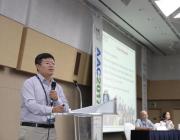摘要:
Multiple approaches were used to investigate the evolution of surface aerosols in Beijing during the passage of a dust event at high altitude, which was from the Gobi areas of southern Mongolia and covered a wide range of North China. Single particle analysis with electron microscope showed that the majority of coarse particles were mineral ones, and most of them were in the size range of 1-7 mu m with a peak of number concentration at about 3.5 mu m. Based on elemental composition and morphology, the mineral particles could be classified into several groups, including Si-rich (71%), Ca-rich (15%), Fe-rich (6%), and halite-rich (2%), etc., and they were the main contributors to the aerosol optical depth as the dust occurred. The sizedistributions of surface aerosols were significantly affected by the dust intrusion. The average number concentration of accumulation mode particles during the event was about 400 cm(-3), which was much lower than that in heavily polluted days (6300 cm(-3)). At the stage of floating dust, the number concentration of accumulation mode particles decreased, and coarse particles contributed to total volume concentration of particulate matter as much as 90%. The accumulation mode particles collected in this stage were mostly in the size range of 0.2-0.5 mu m, and were rectangular or spherical. They were considered to be particles consisting of ammonium sulfate. New particle formation (NPF) was observed around noon in the three days during the dust event, indicating that the passage of the dust was probably favorable for NPF. (C) 2016 Elsevier B.V. All rights reserved.附注:
ISI Document Delivery No.: DP0UVTimes Cited: 8Cited Reference Count: 50Hu, Wei Niu, Hongya Zhang, Daizhou Wu, Zhijun Chen, Chen Wu, Yusheng Shang, Dongjie Hu, MinWu, Zhijun/A-7041-2012; HU, Wei/M-4751-2018HU, Wei/0000-0002-0416-1130; Zhang, Daizhou/0000-0002-1448-2325National Natural Science Foundation of China [91544214, 41541038, 21190052]; Education Bureau of Hebei Province for Excellent Young Scholars [YQ2014020]; Natural Science Foundation of Hebei Province [D2016402120]; State Scholarship Fund of Chinese Scholarship Council (CSC) [201406010350]This research was funded by the National Natural Science Foundation of China (91544214, 41541038 and 21190052), the Education Bureau of Hebei Province for Excellent Young Scholars (YQ2014020) and the Natural Science Foundation of Hebei Province (D2016402120). Mr. W. Hu is supported by the State Scholarship Fund of Chinese Scholarship Council (CSC No. 201406010350). The authors thank Prof. J. Morrow in Prefectural University of Kumamoto for grammar and word editing.8292Elsevier science bvAmsterdam1879-1026